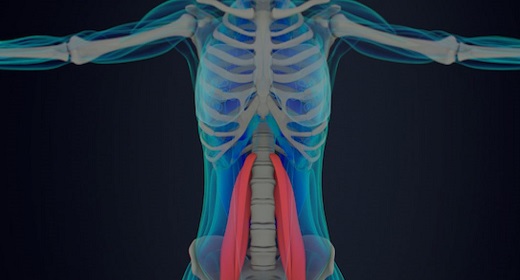by Julie Peters: A simple yoga flow can alleviate your tight psoas, which could be causing you lower back pain, digestive and fertility issues, chronic stress, and more…
The psoas (pronounced “so-az”) is a muscle that attaches at the vertebrae of the mid-to-low back and then runs essentially through the guts on either side of the body into the pelvis. It then attaches at the femur bone in your inner thigh. Your two psoas (or psoae, if you want to use an alternate way to make psoas plural) are the only muscles that connect your legs to your spine. They are involved in hip flexion as well as walking. The psoas muscles can help move lymph through the body and massage the intestines, aiding with digestion.
Animals psoas are known on menus as tenderloin. The funny word comes from the Greek for “of the loins”—and it is most certainly a tender place!
Symptoms of Tight Psoas
- Lower back pain. This is probably the most common symptom of tight psoas. You may also feel pain in the hip and pelvis, often when one psoas is tighter than the other.
- Sometimes when people seem to have one leg shorter than the other, it’s because the psoas is pulling that one leg up out of alignment.
- Digestive issues. Constipation, especially, can be related to tight psoas. They run right through the intestines and can restrict proper gut motility if they are restricting space in the belly.
- Fertility issues. The psoas are nestled right up against the ovaries in a female body, and chronic tightness can send a stress response that might mess with hormonal balance and fertility. It could also contribute to menstrual pain.
- Chronic stress. Chronically tight psoas muscles send a message to the brain that we are in fight-or-flight mode, partly because we tend to contract and pull our legs in when we are afraid. Opening this area can have a calming effect on the body, which can help rebalance all kinds of systems in the body, including digestion, hormones, fertility, immune system, and so on.
Causes for a Tight Psoas
Just as a tight psoas can contribute to stress, stress can contribute to tight psoas. Sitting for long periods of time can also lock the psoas into a tight position, so especially if your stress is work-related, it’s super important to get up and stretch out from time to time.
Running and cycling also tend to work the psoas, which is good, but these muscles can get overly tight if you don’t stretch them out properly after a workout.
Something as simple as sitting with the same leg crossed over the other can contribute to an imbalance in the psoas over time.
Yoga for Psoas Release
There are several great exercises from yoga that you can try to help your psoas release. These are generally safe for most bodies, but check with your practitioner before you do them, especially if you are pregnant or have injuries. Don’t do anything that hurts.
Constructive Rest Pose: Lay down on your back with your knees bent and your feet on the floor. Widen the feet a bit so the knees can fall in towards each other (don’t worry if they don’t touch). This position naturally allows the psoas to release. Focus on breathing deeply into the belly, releasing any tension you might be holding in the abdomen.
Supported Bridge: From this position, steady your feet on the floor, lift up your hips, and slide a prop like a block, pillow, or bolster underneath your hips. Try to place it on the hard ridge of the back of your pelvis, not in your lower back vertebrae. Continue to breathe into the belly, focusing especially when relaxing on the exhale. You may feel something deep in your belly that some people describe as queasiness—that’s your psoas releasing.
Supported Wind Release Pose: From Supported Bridge, if all is well, point the knees straight up to the sky and try straightening out your right leg onto the floor in front of you. Press gently forward through the back of the heel, not lifting the leg, but stretching it forward from the belly. If this feels good, you could lift up your left knee and hug it in towards your chest and then gently pull it to the left, towards your shoulder. Keep breathing into the belly for 5-10 breaths and then switch sides.
When you’re ready, lift your hips off the prop and come back down to your back. Roll to one side and come to seated, and eventually to standing—take your time as you might get dizzy if you come up too fast.
Warrior One: From standing, step your right foot back about a leg’s length or a little less. Keep the feet hips-width apart, and angle your right foot about 45 degrees off to the right. Press your right heel into the ground and tuck your tailbone as you work to keep the back leg straight. Square your hips forward to the front of the room. Keep that as you bend your front knee over your ankle. If you like, reach the arms up to the sky, keeping your front ribs hugging in. You should feel a stretch along the front of the right thigh and possibly up into your belly as well. Take 5-10 deep breaths, breathing into the belly but keeping the tailbone drawing down and the ribs in. Then switch sides.
When this short sequence is complete, lie down again, with your knees bent as when we started, or out straight if you prefer. Relax for several minutes, continuing to breathe into your belly.










































